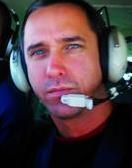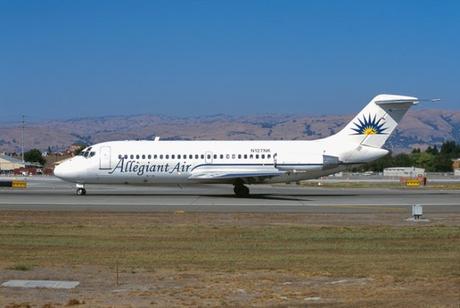
The DC-9 at Skydive Perris takes to the skies!
As reported by Airways MagazinePerris, California is a small town just 71 miles from Los Angeles. Many residents of the metroplex move there for the additional space and the relaxed atmosphere.However, it is well-known as a city famous for its skydiving operations. Skydive Perris is the main skydive company in the area, using their own airport, Perris Valley Airport (L65), for their jumps. With its proximity to Hollywood, Skydive Perris has had a number of celebrity clients, like Tom Cruise, James Corden, magician David Blaine, and Daniel Craig as James Bond in Quantum of Solace.
Skydive Perris has many aircraft in its fleet, including traditional jump planes, like the Cessna 182 and DeHavilland DHC-6 Twin Otter. They also have the rare Shorts SC7 Skyvan (only 149 ever made) as well as a Douglas DC-3.
All of these aircraft are used throughout the world for skydiving operations, but there is one aircraft that is extremely unique to Skydive Perris: the McDonnell Douglas DC-9-21. The aircraft, N127NK, has been with Skydive Perris since 2003, but it has not flown since 2013. However, it is now being prepared to be returned to regular service.

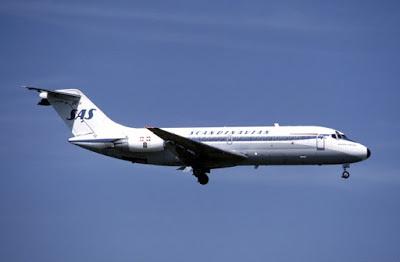
The DC-9-21 was initially requested by Scandinavian Airlines (SAS) for use on short runways in Northern Europe. The -21 model combined the large wing and slats from the -30 with the small body of the -10. The order was only for 10 aircraft, but McDonnell Douglas obliged in its creation.
The final DC-9-21, line number 488, rolled out of the McDonnell Douglas factory in Long Beach, CA in April of 1969, registered as SE-DBO. It made its first flight on April 15th and flew east to Stockholm, Sweden on May 1 to begin its career with SAS with the name “Siger Viking” SAS had its first 3 DC-9-21s registered in Denmark with “OY” registration prefixes, its next 3 in Norway with “LN” registration prefixes, and its final 4 in Sweden with “SE” registration prefixes.
The aircraft spent 26 years flying throughout northern Europe. In October 1990, all of SAS’s DC-9-21s were re-registered as aircraft based in Denmark. The registration of SE-DBO was changed to OY-KIC. However, while the rest remained in Denmark, this aircraft was taken back to Sweden and re-registered back to SE-DBO in June of 1991.

This was in anticipation of it being wet-leased to the Swedish start-up charter airline, Nordic East Airlines, based in Stockholm. The aircraft flew with Nordic East from August of 1991 to May of 1992, when it was replaced with MD-82s, also wet-leased from SAS.
SE-DBO continued its journey with SAS until March of 1995, when it was retired from its fleet. Shortly after, it was acquired by Spirit Airlines in May of 1995, and flown to its new base in Detroit (DTW). Two other DC-9-21s from SAS also joined Spirit at the same time. Once the aircraft came to the US, it was re-registered as N127NK, the same one which it wears today. It flew passengers from Detroit to various destinations Florida and the northeast for just six months, when it was sold to ValuJet Airlines out of Atlanta (ATL) in December of 1995 along with Spirit’s other two DC-9-21s.
ValuJet connected ATL and Orlando (MCO) with the entire Eastern Coast of the USA. From 1995, ValuJet had been the focus of many FAA investigations into aircraft safety. Many accused the airline of not properly maintaining their aircraft, including the Atlanta FAA office, when they sent an official report to their headquarters to force the airline to recertify themselves as an airline. They had 57 emergency landings in both 1995 and 1996, a scaled rate that was 14x more than legacy airlines of the time. This all built up to the famous ValuJet 592 crash on May 11, 1996. The investigation into the crash revealed many safety issues with the fleet that were not being addressed.
A month after the crash, the FAA grounded the entire airline. At this time, N127NK was stored in Lake City, FL and never flew again for ValuJet. The airline later merged with AirTran Airways, but ValuJet’s CEO, Maurice Gallagher, left to build a new airline, Allegiant Air, out of Las Vegas (LAS).
The airline only had two scheduled routes, from Fresno (FAT) and Colorado Springs (COS) to LAS, but was regularly doing casino charters to LAS and various other cities like Reno (RNO), South Lake Tahoe (TVL), and Laughlin (IFP). N127NK was the first aircraft in Allegiant’s fleet, and flew with them until the end of 2002, when it was stored in Victorville (VCV). It spent one year in VCV before Skydive Perris’ owner Ben Conaster had a wild idea. He wanted to use a commercial jetliner for skydiving.

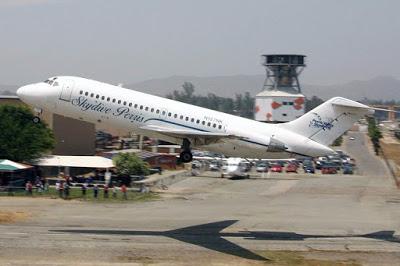
Jumping from large aircraft isn’t necessarily a new idea. The military has been deploying paratroopers for many years. However, the most famous case of this happened on November 24, 1971, when a man going by the alias “D.B. Cooper” boarded a Northwest Orient Airlines Boeing 727-100 from Portland (PDX) to Seattle (SEA). He demanded that he receive $200,000 upon landing in SEA, and that he would like to flee to Mexico City via Reno (RNO).
He also requested that the aircraft remain at 10,000 ft. with the landing gear down, the flaps set at 15°, and the cabin to remain unpressurized. D.B. Cooper jumped from the aircraft via the rear airstairs commonly found on large T-tail aircraft while the they flew over the Washington-Oregon border. The case was never solved, but not for a lack of trying. Now, Skydive Perris is giving the everyday person the opportunity to experience the same thrill that D.B. Cooper had, without the large payout.
The DC-9-21 was destined for the scrapper when it was purchased in 2003 for just $50,000. It took three years to get the aircraft back to flying conditions and get it prepared for skydiving operations. The FAA made Skydive Perris go through many legal and safety-oriented hurdles to make sure that the aircraft would be fit for its new missions. While they were waiting for approval, the aircraft carried supplies to New Orleans after Hurricane Katrina, and evacuated people to Houston as well.
Finally, on December 30, 2006, N127NK took to the skies to drop people from the rear air-stairs, thus becoming the only former commercial jet certified for skydiving operations in the world, a title it still holds today. It can carry divers up to 13,000 ft. in just four minutes, a quarter of the time needed for a Twin Otter to do it. To accommodate the large aircraft, Perris Valley Airport’s runway was lengthened from 3,000 ft. to 5,100 ft. Of all commercial jets, the DC-9-21 is likely to be the best possible one due to its short field performance and the ability to jump out of a pre-existing rear door on the back of the aircraft.
Skydive Perris operated the DC-9 from 2006 to 2013. However, they had issues with its reliability and the ability to find spare parts. This was especially trying with the largest DC-9 operator in the world, Delta Air Lines, retiring their fleet in early 2013. The DC-9 sat derelict with hope for it to take to the skies again, but without a clear-cut plan.
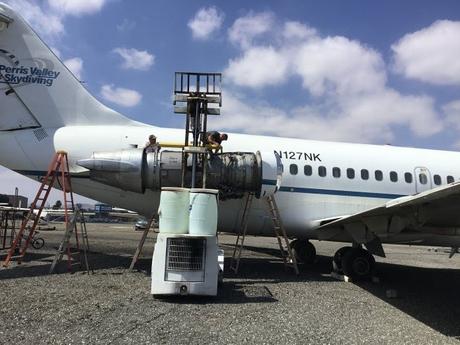
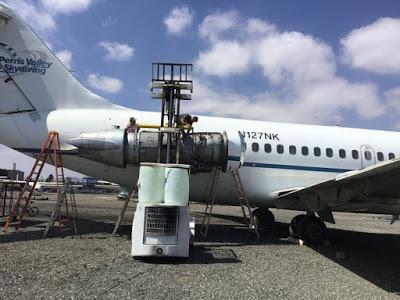
However, in September, after seven years, Skydive Perris announced that the aircraft was undergoing its final repairs, and would take to the skies once again. Engine checks have been completed, and the aircraft has even done taxing tests at L65. Earlier this week, Skydive Perris opened up a job opportunity for some lucky pilots to have the chance to fly the aircraft for them, truly marking the fact that the aircraft will soon take to the skies.
The DC-9 was a stalwart in the aviation industry for many years, but has now been almost completely removed from passenger operations. Only 35 of the 976 DC-9s that have been produced are currently flying, with just one aircraft still flying civilian passengers.
Enthusiasts have requested that Skydive Perris offer flights to aviation enthusiasts without requiring them to jump out of the aircraft. The company has not been accepting to such an idea in the past, but do seem to be a bit more open to the idea this time around. This would truly be a once-in-a-lifetime chance to experience a small part of history, whether you land on the DC-9 or you jump out of it during the flight. Either way, it will be great to see this old bird fly once again.
